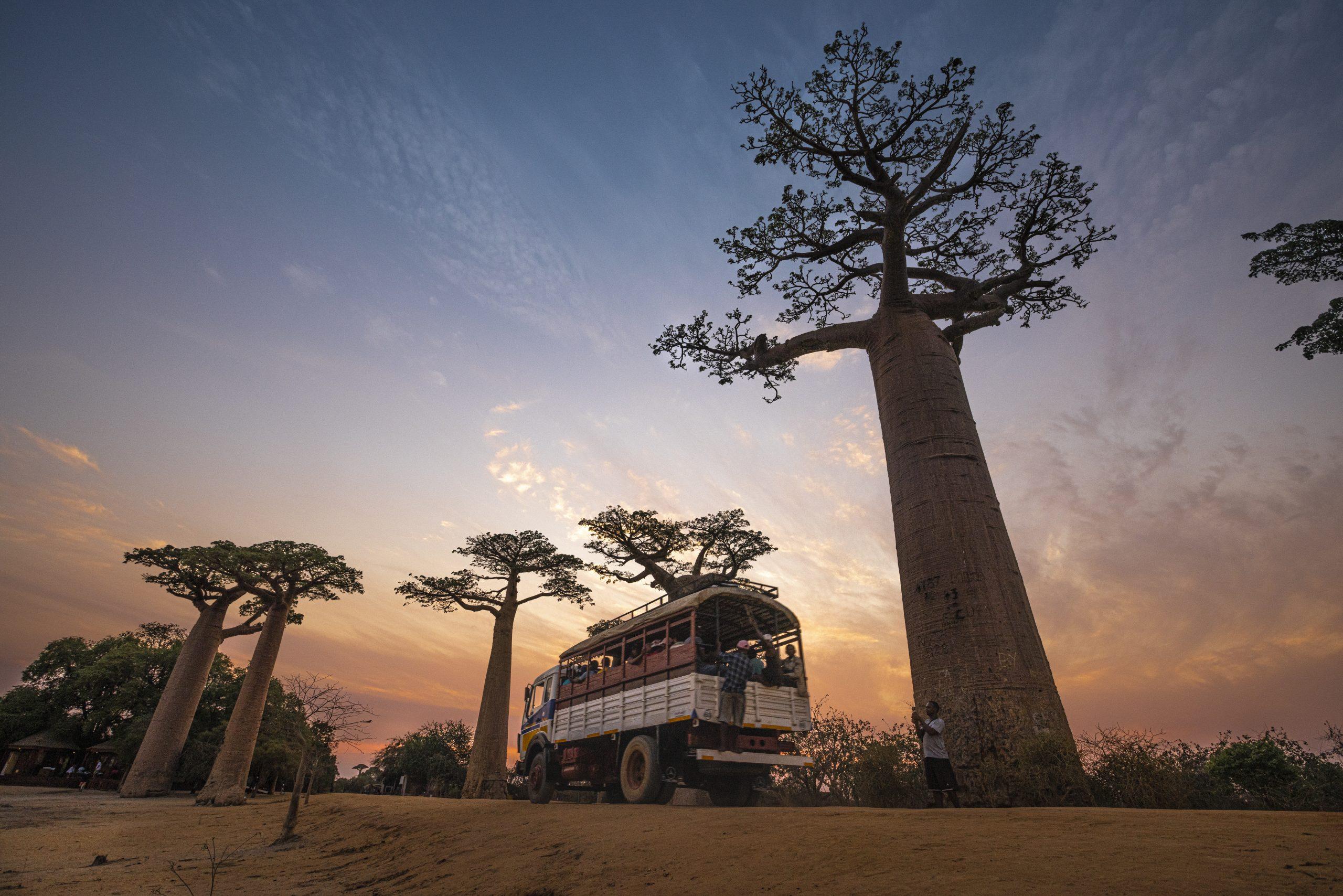The world’s largest baobab and the baobab avenue
Defined as a tropical African tree with a huge trunk, the baobab is an emblematic Madagascan tree. There are eight species of baobab in Africa, six of which are endemic to Madagascar. A majestic and sacred tree, it is also surrounded by many myths due to its very specific appearance. It is profitable, beneficial and attracts the curiosity of many tourists. It is found mainly in the south-west of Madagascar, but also in other regions of the island.
A tree with a big trunk :
As a large tree in the hot regions of Africa and Asia, the baobab has a huge trunk with smooth bark and a dizzying height. This gives it the particularity of absorbing and reserving a maximum amount of water during the rainy season. Thanks to its fibrous texture and the thickness of its trunk, it can store 120 to 140,000 liters of water. The trunks are then hollowed out and filled with water, as on the Mahafaly plateau in southern Madagascar. It is also world-renowned for its ability to store water underground for up to 20 years. This makes it an essential source of water for survival and coping with the long, harsh drought season.
A massive tree with spreading branches :
The baobab is a massive tree with spreading branches found in the savannahs of Africa. Its growth is mainly slow and varies according to climate and region. The largest baobab in the world today is Tsitakakoike, a giant baobab of the grandidieri species found in the Adombiry forest in the north-east of the Morombe region, measuring 27.30 m in circumference. A baobab can exceed a diameter of 10 and reach a height of 30 m, with a very massive size. Its maximum age is 2000 years. The oldest known baobab in Madagascar is 1600 years old, belonging to the Adansonia rubrotispa species, located in the Tsimanapetsotse park south of Tuléar. Its first fruits appear around 15 to 25 years old in South and East Africa, and up to 200 years old in the driest parts of South Africa. In Madagascar, there are several types of baobab, including those with long, slender trunks, thick, cone-shaped trunks and swollen, bottle-shaped trunks with spreading branches that dominate vast stretches of nature. Despite the imposing size of its trunk, its main roots are shallow and rarely extend more than 2 m below the ground. For this reason, they are highly susceptible to cyclones and storms or other violent gales that could occasionally uproot them. The baobab almost never grows very far from the ocean on Madagascar’s coasts, especially in the western part of the island, as the most famous is found right by the sea in Majunga. Monkey bread, the fruit of the baobab, called Bouye be in Malagasy, has even become the town’s symbol.
A tree linked to Africa’s greatness :
This tree is linked to the greatness of Africa and its culture. Reputed to be a mythical tree, the best-known myth about the baobab is that it was planted upside down by God because He was angry about something indefinite; it’s called “upside down” because its branches resemble giant roots. In Madagascar, some baobabs are even said to hold evil spirits, which they release when night falls. Its symbolic value varies from country to country. In Madagascar, the baobab is called “reniala”, meaning “queen of the forest”, and the tallest tree in a huge baobab forest is revered by the locals. The landscape of the south and west of the island, characterized by the baobab, is even reflected on one side of the 50 ariary coin.
The baobab is indispensable in everyday life :
Not only does baobab fruit contain twice as much vitamin C as oranges, it is also known for its high calcium content. This makes baobab an indispensable part of everyday life. Its tangy, ovoid fruit is edible, and its pulp is used to stimulate the body and relieve intestinal problems. The oil from its seeds has been proven to help care for dry skin and hair. A porridge of dried baobab bark is used as a medicine to treat fever and high temperatures. Its leaves boost energy and fight fatigue, while strengthening bones. Baobab wood is also used as a building material, especially for tiles and walls. In short, baobabs are extremely useful.
A rare form: the Baobab in love :
There is a rare form of baobab found only in the Menabe region in the west of the island, known as the “love baobab”. A single tree with two intertwining trunks, it can reach 30 m in height. A remarkable tree with a shape that resembles two inseparable lovers, it takes its name from this specific feature. The fact that they intertwine indicates an eternal union, and it’s part of the “Adansonia Fony” species. It fascinates many visitors and attracts the admiration of tourists. Some people believe that when two couples walk at the foot of this baobab and write their names on the tree trunk, the baobab may bring them wealth and the good fortune never to part again.
Numerous sightseeing tours at your disposal :
There are special tours dedicated to baobab discovery. Following the Mangoky River is one of the best ways to admire the baobabs and discover a rare paradise landscape. The incredible Allée des Baobabs (Baobab Alley), a small overland lane lined with numerous baobabs over 30 m high and over 800 years old, is a must-see when visiting south-west Madagascar for nature lovers and keen photographers. In this particular spot, the baobab trees are neatly aligned, offering a unique and exceptional view at sunrise and sunset. This alley is one of Madagascar’s most beautiful sites, a true national heritage. It allows visitors to appreciate these gigantic trees. Views also allow us to contemplate the baobabs lining the watercourse and filling the canyon floor. For an unforgettable experience, we recommend attending the baobab festival.






